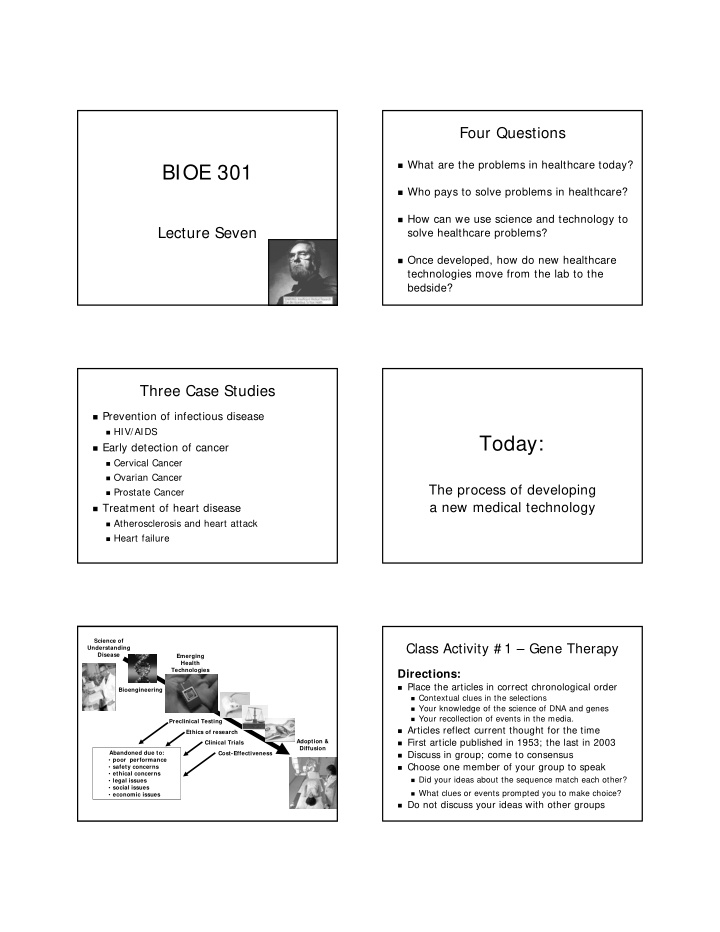



Four Questions � What are the problems in healthcare today? BIOE 301 � Who pays to solve problems in healthcare? � How can we use science and technology to Lecture Seven solve healthcare problems? � Once developed, how do new healthcare technologies move from the lab to the bedside? Three Case Studies � Prevention of infectious disease � HIV/AIDS Today: � Early detection of cancer � Cervical Cancer � Ovarian Cancer The process of developing � Prostate Cancer a new medical technology � Treatment of heart disease � Atherosclerosis and heart attack � Heart failure Science of Class Activity # 1 – Gene Therapy Understanding Disease Emerging Health Technologies Directions: � Place the articles in correct chronological order Bioengineering � Contextual clues in the selections � Your knowledge of the science of DNA and genes � Your recollection of events in the media. Preclinical Testing � Articles reflect current thought for the time Ethics of research � First article published in 1953; the last in 2003 Adoption & Clinical Trials Diffusion Abandoned due to: Cost-Effectiveness � Discuss in group; come to consensus • poor performance � Choose one member of your group to speak • safety concerns • ethical concerns � Did your ideas about the sequence match each other? • legal issues • social issues � What clues or events prompted you to make choice? • economic issues � Do not discuss your ideas with other groups
Science of Question: Understanding Disease Emerging Health Technologies � What is the difference between science and engineering? Bioengineering Preclinical Testing Ethics of research Adoption & Clinical Trials Diffusion Abandoned due to: Cost-Effectiveness • poor performance • safety concerns • ethical concerns • legal issues • social issues • economic issues Definitions Definitions � Science � Engineering � Body of knowledge about natural phenomena � Systematic design, production and operation which is: of technical systems to meet practical human � Well founded needs under specified constraints � Testable � Time � Purpose is to discover, create, confirm, � $$ disprove, reorganize, and disseminate � Performance statements that accurately describe some � Reliability portion of physical, chemical, biological world � “Engineering. . . in a broad sense. . . is � “Science is the human activity of seeking natural explanations for what we observe applying science in an economic manner in the world around us.” to the needs of mankind “ Definitions Engineering Design Method � What is the difference between science � Fashioning a product made for a practical and engineering? goal in the presence of constraints � Science � Six design steps: � Inquiry to better understand world around us � 1. Identify a need � No practical goal necessary SPECS � 2. Define the problem (goals, constraints) � Engineering � 3. Gather information � Use of science to solve real world problem in � 4. Develop solutions practical way Refine Design � 5. Evaluate solutions � 6. Communicate results � Papers, patents, marketing
Journal Article Patent � www.uspto.gov � Diagnostic Imaging Patent Example: Oral cancer detection Histology of Oral Cancer � Science of precancer � Engineering solutions for precancer detection � 1. Identify a need � 2. Define the problem (goals, constraints) � 3. Gather information � 4. Develop solutions � 5. Evaluate solutions � 6. Communicate results Clinical Needs � High sensitivity and specificity � Relative to standard of care � Relative to clinical impression or gold standard � Survey all tissue at risk � Detect precursor or early disease
Multispectral Digital Microscope Imaging modes: • Reflectance - Multispectral - Polarized • Fluorescence Typical Lesions of the Four Portable Screening System Diagnostic Categories LED light source Battery powered Abnormal Abnormal Cancer Normal High Risk Low Risk 3 Image Modes: White light Fluorescence WL Polarized Records digital images FL
Commercial Device Image Analysis Normalized Ratio of Red to Green MFI Technology: Confocal Microscopy Sample Point Source Beamsplitter Illumination Rejected Light Image Rejected Pinhole Plane Plane Accepted Light Detector Webb, J. Investigative Dermatology,1995 Confocal Microscope Imaging Endogenous Contrast
LED Source CCD Camera Dichroic Tube Lens 10X UPLAPO Mirror Objective Image Guide Needle Biopsy Frame Grabber Needle Biopsy Needle Biopsy Miniature Microscopes Collaboration with T. Tkaczyk
Example: Oral cancer detection � Science of precancer � Engineering solutions for precancer detection � 1. Identify a need � 2. Define the problem (goals, constraints) � 3. Gather information � 4. Develop solutions � 5. Evaluate solutions � 6. Communicate results Three Case Studies Assignments Due Next Time � Prevention of infectious disease � None! � HIV/AIDS � Early detection of cancer � Cervical Cancer � Ovarian Cancer � Prostate Cancer � Treatment of heart disease � Atherosclerosis and heart attack � Heart failure
Recommend
More recommend